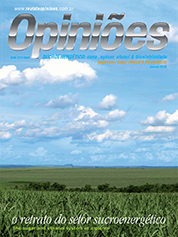Ana Paula Malvestio
Partner at PricewaterhouseCoopers
Op-AA-25
Changes brought about by the crisis versus changes brought about by the market
Resilience of the currently so-called sugar-based energy industry to periods of crisis is something that merits our reflexion. A concept derived from physics, resilience relates to the property of some materials, whereby they accumulate energy when used or submitted to stress, without the occurrence of any rupture. After tension ceases, deformation may or may not have occurred – like something elastic or a jumping pole.
Applying this to business, one may define it as the capacity of an individual or a company to adapt to changes. This is exactly what one observes in the industry when looking at what happened in the two last big crises of 1998-99 and 2008-09 and their respective causes. The first began due to low sugar and ethanol prices in the market, aggravated by the freeing of the exchange rate.
It is quite impressive to think that ten years later the story is the same all over again, with sugar and ethanol prices, after two years went by, reflecting an unattractive remuneration to cover costs, and with the crisis aggravated by the global financial crisis that resulted in the freeing of the exchange rate and the lack of credit. Resilience was clearly shown throughout the sugar, ethanol and energy chain, but certainly none of the links came out or will come out in the same way they went into the crisis.
Looking at the producers, in 1998-99 the path taken by mills to survive the crisis was to restructure and seek efficiency. At the time, what started hap-pening were family successions, professionalization, the quest for cost reductions, investment in people and productivity. As a result, mills stood out as a reference in the industry, and to exemplify one may mention the São Martinho, Santa Elisa, Vale do Rosário, Moema and Nova América mills, the latter the origin of nowaday’s Cosan, among many others.
However, this trend did not affect all producing mills/groups and even nowadays one can notice the shortcomings in terms of controls, transparency, budgets, strategies, the separation of partner and company equity, among other aspects one may refer to as corporate governance. The 2008-09 crisis in turn caught many of the traditional mills/groups and a number of newcomers highly leveraged, caused by the outlook for ethanol in the world, and represented a divisor of waters that brought about radical change to the industry’s profile.
With the realization of mergers and acquisitions, the sugar-based energy industry quickly developed towards its 1. concentration, 2. verticalization, and 3. internationalization, which will require of the “survivors”, the “resilient” ones, their full commitment to changes. From another perspective, one could say that the resilience of participants in the sugar-based energy industry after the 2008-09 crisis will depend on the agility to identify, understand, accept and implement changes that will be dictated no longer by cyclic crises, but rather by a dynamic and competitive market.
Therefore, the excellent scenario projected for the future of sugar, ethanol and co-generation of energy will depend on industry participants’ aptitude to prepare for these changes in the market that will strongly grow the industry. One should emphasize:
- more competitiveness, characterized by players taking part in such a way that their investments will no longer be financed by the cash flow from the previous harvest, but rather, by special funds originating from access to capital markets and international lines of credit;
- access to international markets that will make customer fidelity and higher product prices possible, along with the exclusion of intermediaries. In this respect, one will see Louis Dreyfuss, Bunge, Renuka, Shell, BP, Petrobras, among others;
- access to the logistics organization that will be essential to bring production to market from the new sugarcane frontiers, as well as the traditional ones, by means of pipelines, multi-modal transportation, port terminals, etc;
- adaptation to norms related to Brazil’s and the world’s sustainable development, particularly with respect to environmental and labor issues; and
- increasingly more transparent and efficient management of costs and risks, with the constant quest for economies of scale, along the same lines of what some of the large groups are currently already practicing.
In view of this huge challenge to adapt to the previously mentioned changes, of which only some were listed, one may no doubt predict the enormous difficulty that small groups and/or mills will face. Thus, in light of the recovery scenario expected for 2010/11, why not seek a new order, in which there would be no buyers and sellers, but only partners that would unite to seek resilience in this “new face” industry.
The reflexion proposed is based on the notion that nowadays much more exists to unite groups/mills than there is to separate them. To face so many changes is suf-ficient reason to seek a union, an agglomeration, which, fostered by best practices in corporate governance currently available, will allow for perpetuality and sustainability in their business.
Unlike a merger operation, in which two parties usual-ly disappear to make room for a new entity, or an acquisition, in which one of the parties disappears allowing for the other to survive, what one proposes is a union, an agglomeration, in search of common objectives – to be prepared to enjoy the benefits of ethanol as a commodity, of sugar with an excellent foreign market, of abundant energy as yet not explored, of diesel from sugarcane which arises as a possibility, along with so many other excellent perspectives for the sugar-based energy industry. So, why not join efforts?




